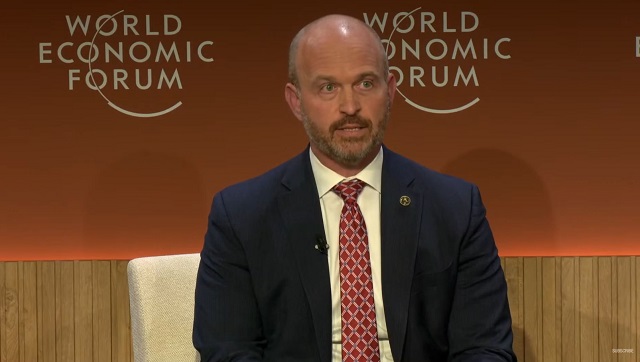Economy
Heritage Foundation president tells Davos: Future Trump admin must reject all WEF ideas

Heritage Foundation President Kevin Roberts at the World Economic Forum meeting in Davos
From LifeSiteNews
The Heritage Foundation’s Kevin Roberts said that everyone in the next administration must ‘compile a list of everything that’s ever been proposed at the World Economic Forum’ and object to ‘all of them, wholesale.’
The president of the conservative Heritage Foundation in said in his appearance at Davos that the next Republican administration needs to reject “everything that’s ever been proposed at the World Economic Forum.”
Kevin Roberts, head of the Heritage Foundation, the leading conservative think tank in the U.S., said during a panel discussion called “What to Expect from a Possible Republican Administration?” that “the kind of person who will come into the next conservative administration is going to be governed by one principle and that is destroying the grasp that political elites and unelected technocrats have over the average person.”
BREAKING – @Heritage President @KevinRobertsTX calls out globalist elites at WEF
He said the next Republican administration needs to “compile a list of everything that’s ever been proposed at the World Economic Forum and object [to] all of them, wholesale.” #WEF24 pic.twitter.com/DXmlZUoCOA
— Andreas Wailzer (@Andreas_Wailzer) January 18, 2024
“And if I may, I will be candid and say that the agenda that every single member of the administration needs to have is to compile a list of everything that’s ever been proposed at the World Economic Forum and object [to] all of them, wholesale.”
“Anyone not prepared to do that and take away this power of the unelected bureaucrats and give it back to the American people in unprepared to be part of the next conservative administration.”
Trump admin will ‘trust the science’ and reject push of gender ideology
Roberts said that the idea that the WEF is defending “liberal democracy” and the suggestion that Trump would be a “dictator” are both “laughable.”
My message to the self-appointed global elites: Your time is up. pic.twitter.com/Wj2Bntjztz
— Kevin Roberts (@KevinRobertsTX) January 18, 2024
“Whoever is the next conservative president is going to take on the power of the elites,” he declared.
“Political elites tell the average people on three or four or five issues, that the reality is X, when in fact reality is Y.”
Roberts went on to list five things as examples that President Trump will take on if he is elected:
“Take immigration: elites tell us that open borders and even illegal immigration are okay, the average person tells us in the United States that both rob them of the American way of life.”
“Elites also tell us that public safety isn’t a problem in American cities. Just travel to New York or Washington or Dallas, Texas. The average person will tell you that the lack of public safety damages not just the American way of life but their life.”
“Thirdly, I guess the favorite at the World Economic Forum, is climate change. Elites tell us that we have this existential crisis with so-called ‘climate change,’ so much so that climate alarmism is probably the greatest cause for [the] mental health crisis in the world. The solutions, the average person knows, based on climate change are far worse and more harmful and cost more human lives, especially in Europe during the time that you need heating, than to the problems themselves.”
“The fourth: China. The number one adversary not just to the United States but to free people on planet Earth. Not only do we at Davos not say that, we give the Chinese Communist Party a platform. Count on President Trump ending that nonsense.”
“And fifth, another supernational organization, the World Health Organization, is discussing foisting gender ideology upon [the] Global South. These are practices that are under review if not being rejected, by countries in Northern Europe.”,
“The new president, especially if it is President Trump, will, as you like to say, ‘trust the science.’ He will understand the basic biological reality of manhood and womanhood.”
“I think President Trump, if in fact he wins a second term, is going to be inspired by the wise words of Javier Milei, who said that he was in power not to guide sheep but to awaken lions,” Roberts concluded.
Roberts: ‘I’ll probably never be invited back’ to the WEF
In a video published on his X account shortly before his appearance in Davos, Roberts said that “for too long, the self-appointed globalist elites at the World Economic Forum in Davos Switzerland have lorded over you and me.”
This morning, I'll be joining #WEF24 to usher the Davoisie into early retirement. Tune in live at 10:15 a.m. EST.
🔗: https://t.co/VIJtdayL8b pic.twitter.com/Oozlr19HmW
— Kevin Roberts (@KevinRobertsTX) January 18, 2024
“And you’ll never guess, the president of the Heritage Foundation was invited this year to go, and against my preference, I’m going, on your behalf, to read those people the riot act.”
“Their time of lording over us has come to an end, whether it’s COVID lockdowns, riding over there in their beautiful fancy private jets while lecturing us at the same time, sometimes while on the plane, that climate change is an existential threat.”
“I’m going to talk about all of it. I’ll probably never be invited back, but considering I never wanted to go in the first place, I look forward to it.”
Automotive
Federal government should swiftly axe foolish EV mandate

From the Fraser Institute
Two recent events exemplify the fundamental irrationality that is Canada’s electric vehicle (EV) policy.
First, the Carney government re-committed to Justin Trudeau’s EV transition mandate that by 2035 all (that’s 100 per cent) of new car sales in Canada consist of “zero emission vehicles” including battery EVs, plug-in hybrid EVs and fuel-cell powered vehicles (which are virtually non-existent in today’s market). This policy has been a foolish idea since inception. The mass of car-buyers in Canada showed little desire to buy them in 2022, when the government announced the plan, and they still don’t want them.
Second, President Trump’s “Big Beautiful” budget bill has slashed taxpayer subsidies for buying new and used EVs, ended federal support for EV charging stations, and limited the ability of states to use fuel standards to force EVs onto the sales lot. Of course, Canada should not craft policy to simply match U.S. policy, but in light of policy changes south of the border Canadian policymakers would be wise to give their own EV policies a rethink.
And in this case, a rethink—that is, scrapping Ottawa’s mandate—would only benefit most Canadians. Indeed, most Canadians disapprove of the mandate; most do not want to buy EVs; most can’t afford to buy EVs (which are more expensive than traditional internal combustion vehicles and more expensive to insure and repair); and if they do manage to swing the cost of an EV, most will likely find it difficult to find public charging stations.
Also, consider this. Globally, the mining sector likely lacks the ability to keep up with the supply of metals needed to produce EVs and satisfy government mandates like we have in Canada, potentially further driving up production costs and ultimately sticker prices.
Finally, if you’re worried about losing the climate and environmental benefits of an EV transition, you should, well, not worry that much. The benefits of vehicle electrification for climate/environmental risk reduction have been oversold. In some circumstances EVs can help reduce GHG emissions—in others, they can make them worse. It depends on the fuel used to generate electricity used to charge them. And EVs have environmental negatives of their own—their fancy tires cause a lot of fine particulate pollution, one of the more harmful types of air pollution that can affect our health. And when they burst into flames (which they do with disturbing regularity) they spew toxic metals and plastics into the air with abandon.
So, to sum up in point form. Prime Minister Carney’s government has re-upped its commitment to the Trudeau-era 2035 EV mandate even while Canadians have shown for years that most don’t want to buy them. EVs don’t provide meaningful environmental benefits. They represent the worst of public policy (picking winning or losing technologies in mass markets). They are unjust (tax-robbing people who can’t afford them to subsidize those who can). And taxpayer-funded “investments” in EVs and EV-battery technology will likely be wasted in light of the diminishing U.S. market for Canadian EV tech.
If ever there was a policy so justifiably axed on its failed merits, it’s Ottawa’s EV mandate. Hopefully, the pragmatists we’ve heard much about since Carney’s election victory will acknowledge EV reality.
Economy
The stars are aligning for a new pipeline to the West Coast

From Resource Works
Mark Carney says another pipeline is “highly likely”, and that welcome news.
While attending this year’s Calgary Stampede, Prime Minister Mark Carney made it official that a new pipeline to Canada’s West Coast is “highly likely.”
While far from a guarantee, it is still great news for Canada and our energy industry. After years of projects being put on hold or cancelled, things are coming together at the perfect time for truly nation-building enterprises.
Carney’s comments at Stampede have been preceded by a number of other promising signs.
At a June meeting between Carney and the premiers in Saskatoon, Alberta Premier Danielle Smith proposed a “grand bargain” that would include a privately funded pipeline capable of moving a million barrels of oil a day, along with significant green investments.
Carney agreed with Smith’s plan, saying that Canada needed to balance economic growth with environmental responsibility.
Business and political leaders have been mostly united in calling for the federal government to speed up the building of pipelines, for economic and strategic reasons. As we know, it is very difficult to find consensus in Canada, with British Columbia Premier David Eby still reluctant to commit to another pipeline on the coast of the province.
Alberta has been actively encouraging support from the private sector to fund a new pipeline that would fulfil the goals of the Northern Gateway project, a pipeline proposed in 2008 but snuffed out by a hail of regulations under former Prime Minister Justin Trudeau.
We are in a new era, however, and we at Resource Works remarked that last month’s G7 meeting in Kananaskis could prove to be a pivotal moment in the history of Canadian energy. An Ipsos poll found that Canada was the most favoured nation for supplying oil in the G7, and our potential as an energy superpower has never been more important for the democratic world, given the instability caused by Russia and other autocratic energy powers.
Because of this shifting, uncertain global climate, Canadian oil and gas are more attractive than ever, and diversifying our exports beyond the United States has become a necessity in the wake of Donald Trump’s regime of tariffs on Canada and other friendly countries.
It has jolted Canadian political leaders into action, and the premiers are all on board with strengthening our economic independence and trade diversification, even if not all agree on what that should look like.
Two premiers who have found common ground are Danielle Smith and Ontario Premier Doug Ford. After meeting at Stampede, the pair signed two memorandums of understanding to collaborate on studying an energy corridor and other infrastructure to boost interprovincial trade. This included the possibility of an eastward-bound pipeline to Ontario ports for shipping abroad.
Ford explicitly said that “the days of relying on the United States 100 percent, those days are over.” That’s in line with Alberta’s push for new pipeline routes, especially to northwestern B.C., which are supported by Smith’s government.
On June 10, Resource Works founder and CEO Stewart Muir wrote that Canadian energy projects are a daunting endeavour, akin to a complicated jigsaw puzzle, but that getting discouraged by the complexity causes us to lose sight of the picture itself. He asserted that Canadians have to accept that messiness, not avoid it.
Prime Minister Carney has suggested he will make adjustments to existing regulations and controversial legislation like Bill C-69 and the emissions cap, all of which have slowed the development of new energy infrastructure.
This moment of alignment between Ottawa, the provinces, and other stakeholders cannot be wasted. The stars are aligning, and it will be a tragedy if we cannot take a great step into the future of our country.
-

 Alberta2 days ago
Alberta2 days agoCOWBOY UP! Pierre Poilievre Promises to Fight for Oil and Gas, a Stronger Military and the Interests of Western Canada
-

 MAiD1 day ago
MAiD1 day agoCanada’s euthanasia regime is already killing the disabled. It’s about to get worse
-

 Crime2 days ago
Crime2 days agoEyebrows Raise as Karoline Leavitt Answers Tough Questions About Epstein
-

 Alberta2 days ago
Alberta2 days agoAlberta and Ontario sign agreements to drive oil and gas pipelines, energy corridors, and repeal investment blocking federal policies
-

 Fraser Institute1 day ago
Fraser Institute1 day agoBefore Trudeau average annual immigration was 617,800. Under Trudeau number skyrocketted to 1.4 million from 2016 to 2024
-

 Censorship Industrial Complex14 hours ago
Censorship Industrial Complex14 hours agoCanadian pro-freedom group sounds alarm over Liberal plans to revive internet censorship bill
-

 Daily Caller2 days ago
Daily Caller2 days ago‘I Know How These People Operate’: Fmr CIA Officer Calls BS On FBI’s New Epstein Intel
-

 International2 days ago
International2 days agoChicago suburb purchases childhood home of Pope Leo XIV


